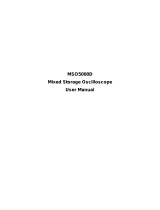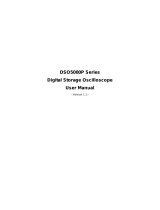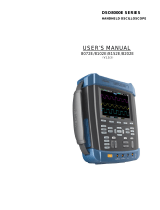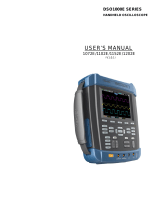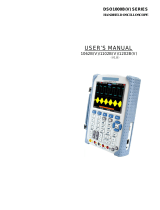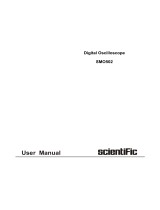
Digital Storage Oscilloscope I
DSO4000B(C) Series
Digital Storage Oscilloscope
User Manual
(Version 1.0)

Digital Storage Oscilloscope II
Copyright Declaration
All rights reserved; no part of this document may be reproduced or transmitted in any
form or by any means, electronic or mechanical, without prior written permission from
Hantek Technologies Co., Ltd (hereinafter referred to as ‘Hantek’).
Hantek reserves all rights to modify this document without prior notice. Please contact
Hantek for the latest version of this document before placing an order.
Hantek has made every effort to ensure the accuracy of this document but does not
guarantee the absence of errors. Moreover, Hantek assumes no responsibility in
obtaining permission and authorization of any third party patent, copyright or product
involved in relation to the use of this document.

Digital Storage Oscilloscope III
General Safety Summary
Read the following safety precautions to avoid injury and prevent damage to this
product or any products connected to it. To evade potential hazards, use this product
only as specified.
Only qualified personnel should perform maintenance.
Avoid fire or personal injury.
Use suitable power cord. Use only the power cord specified for this product and
certified for the country of use.
Connect and disconnect properly. Connect a probe with the oscilloscope before it is
connected to measured circuits; disconnect the probe from the oscilloscope after it is
disconnected from measured circuits.
Ground the product. This product is grounded through the grounding conductor of the
power cord. To avoid electric shock, the grounding conductor must be connected to
earth ground. Before making connections to the input or output terminals of the product,
ensure that the product is properly grounded.
Connect the probe in a right way. The probe ground lead is at ground potential. Do
not connect the ground lead to an elevated voltage.
Check all terminal ratings. To avoid fire or shock hazard, check all ratings and
markings on the product. Refer to the product manual for detailed information about
ratings before making connections to the product.
Do not operate without covers. Do not operate this product with covers or panels
removed.
Avoid exposed circuitry. Do not touch exposed connections and components when
power is present.
Do not operate with suspected failures. If you suspect there is damage to this
product, have it inspected by qualified service personnel.
Assure good ventilation.
Do not operate in wet/damp environments.
Do not operate in an explosive atmosphere.
Keep product surfaces clean and dry.

Digital Storage Oscilloscope IV
Safety Terms and Symbols
Terms on the product. The following terms may appear on the product:
Danger It represents that harms may be caused to you at once if you perform the
operation.
Warning It represents that latent harms may be caused to you if you perform the
operation.
Notice It represents the damage possibly caused to the product or other
properties if you perform the operation.
Characters on the product. The following characters may appear on the product:
Product Scrapping
Device Recycling
We need extract and utilize natural resources to produce this device. If you do not
reclaim the device in a proper way, some substances it contains may become harmful
or poisonous to environments or human bodies. To avoid them being released outside
and to minimize the waste of natural resources, we suggest you reasonably call back
this device to ensure proper recovery and recycling of most materials within it.
Notice
Please read
the manual
Protective
ground terminal
Measuring
ground terminal
Chassis
ground terminal

Digital Storage Oscilloscope IV
Brief Introduction to the Series of digital
storage oscilloscope
DSO4000B(C) Series oscilloscopes cover the bandwidths from 80MHz to 200MHz,
and provide the real-time up to 1GSa/s. In addition, they have 7 inch color TFT LCD as
well as WINDOWS-style interfaces and menus for easy operation.
What’s more, the plenty menu information and the easy-to-operate buttons allow you to
gain information as much as possible in measurement; the multifunctional knobs and
the powerful shortcut keys help you save a lot of time in operation; the Autoset function
lets you detect sine and square waves automatically; the Probe Check Wizard guides
you to adjust the probe compensation and set the Probe option attenuation factor. By
using the three methods the oscilloscope provides (context-sensitive, hyperlinks, and
an index), you may master all operations on the device in quite a short time so as to
greatly improve your efficiency in production and development.
Model
Channels
Bandwidth
Sample Rate
AFG
DSO4084B
4
80MHz
1GS/s
-
DSO4104B
4
100MHz
1GS/s
-
DSO4204B
4
200MHz
1GS/s
-
DSO4254B
4
250MHz
1GS/s
-
DSO4084C
4
80MHz
1GS/s
Yes
DSO4104C
4
100MHz
1GS/s
Yes
DSO4204C
4
200MHz
1GS/s
Yes
DSO4254C
4
250MHz
1GS/s
Yes

Digital Storage Oscilloscope V
Contents
Copyright Declaration ............................................................................................... II
General Safety Summary ...................................................................................... III
Safety Terms and Symbols ................................................................................... IV
Product Scrapping ................................................................................................ IV
Brief Introduction to the Series of digital storage oscilloscope ............................... IV
Contents ................................................................................................................... V
Chapter 1 Introduction ........................................................................................ 1
1.1 General Inspection ................................................................................... 2
1.2 Prepare Instrument for Use ....................................................................... 3
1.3 Accidence of front panel and the user interface ........................................ 1
1.3.1 User Interface ...................................................................................... 1
1.4 Functional Check ...................................................................................... 3
1.4.1 Connect the oscilloscope ..................................................................... 3
1.4.2 Observe the waveform ......................................................................... 3
1.5 Probe Introduction .................................................................................... 4
1.5.1 Safety .................................................................................................. 4
1.5.2 Use of Probe Check Wizard ................................................................. 4
1.5.3 Manual Probe Compensation ............................................................... 4
1.5.4 Probe Attenuation Setting..................................................................... 5
Chapter 2 Function Introduction ........................................................................ 7
2.1 Menu and control keys .............................................................................. 8
2.2 Connector ................................................................................................. 9
2.3 Default setups ........................................................................................... 9
2.4 Multi-functional Knobs and Buttons ......................................................... 10
2.5 Oscilloscope Setup ................................................................................. 10
2.6 Horizontal Controls ................................................................................. 11
2.6.1 Scan Mode Display (Roll Mode) ......................................................... 12
2.7 Vertical System ....................................................................................... 12

Digital Storage Oscilloscope VI
2.7.1 Vertical Controls ................................................................................. 12
2.7.2 Math FFT ........................................................................................... 15
2.8 Trigger System ....................................................................................... 20
2.8.1 Trigger Controls ................................................................................. 21
2.8.2 Holdoff ............................................................................................... 40
2.9 SAVE/RECALL ....................................................................................... 40
2.10 MEASURE System ................................................................................. 42
2.10.1 Scale measurement....................................................................... 42
2.10.2 Cursor measurement ..................................................................... 43
2.10.3 Automatic Measurement ................................................................ 44
2.11 ACQUIRE ............................................................................................... 47
2.12 DISPLAY ................................................................................................ 51
2.12.1 XY Format ..................................................................................... 51
2.13 UTILITY System ..................................................................................... 52
2.13.1 51BFirmware Update ........................................................................... 52
2.13.2 52BSelf Calibration .............................................................................. 53
2.13.3 56BPass/fail ........................................................................................ 53
2.14 Fast Action Buttons ................................................................................. 55
2.14.1 AUTOSET ..................................................................................... 55
2.14.2 Default Setup ................................................................................ 57
Chapter 3 Waveform Generator ........................................................................ 60
Chapter 4 Troubleshooting ............................................................................... 62
4.1 Problem Settlement ................................................................................ 62
Chapter 5 Services and Support ...................................................................... 90
Chapter 6 General Care and Cleaning ............................................................. 91
6.1 General Care .......................................................................................... 91
6.2 Cleaning ................................................................................................. 91
Appendix A: Technical Specifications ................................................................... 92
Appendix B: Accessories ....................................................................................... 99

Chapter 1 Introduction
General Inspection
Prepare Instrument for Use
Accidence of front panel and the user interface
Functional Check
Probe Introduction

1.1 General Inspection
Please check the instrument as following steps after receiving an oscilloscope:
Check the shipping container for damage:
Keep the damaged shipping container or cushioning material until the contents of
the shipment have been checked for completeness and the instrument has been
checked mechanically and electrically.
Check the accessories:
Accessories supplied with the instrument are listed in "Accessories" in this guide. If
the contents are incomplete or damaged, please notify the franchiser.
Check the instrument:
In case there is any mechanical damage or defect, or the instrument does not
operate properly or fails performance tests, please notify the franchiser.

1.2 Prepare Instrument for Use
Adjust the Supporting Legs
Adjust the supporting legs properly to use them as stands to tilt the oscilloscope
upwards for stable placement of the oscilloscope as well as better operation and
observation.
Connect the Power Cord
Connect the power cord as desired. Turn the instrument on by pressing the power
switch in the lower left corner of front panel.
If the instrument does not turn on, verify that the power cord is firmly connected
(power-line voltage is automatically sensed at power-on). Also make sure that the
instrument is connected to an energized power source.
Power Switch:
To turn off the instrument, please press power switch.

Digital Storage Oscilloscope 1
1.3 Accidence of front panel and the user
interface
This section will make you understand the front operation panel of this series of digital
oscilloscope at first before use.
1.3.1 User Interface
Figure 1-2 Interface display
1. Hantek logo
2. Trigger Status:
Auto: The oscilloscope works in auto mode and is acquiring waveforms in the
absence of triggers.
Ready: All pre-triggered data have been acquired and the oscilloscope is ready to
accept a trigger.
Roll: The oscilloscope is acquiring and displaying waveform data continuously in
roll mode.
Stop: The oscilloscope has stopped acquiring waveform data.

Digital Storage Oscilloscope 2
3. Readout shows main time base setting.
4. Sample rate.
5. Main Time Base Window
6. Tigger time
7. Trigger level, Readout tells trigger level
8. Operating Menu shows different information for respective function keys.
9. If this icon lights up/active, it means the USB disk has been connected.
10. If this icon lights up/active, it means the wave generator works
11. The information of coupling, Bandwidth and volt/div of CH1~CH4.
12. Channel Marker
13. Window displays waveform.

Digital Storage Oscilloscope 3
1.4 Functional Check
Follow the steps below to perform a quick functional check to your oscilloscope.
1.4.1 Connect the oscilloscope
Set the switch on the probe to 10X and connect the probe to Channel 1 on the
oscilloscope. First, align the slot in the probe connector with the protuberance on the
CH1 BNC and push to connect; then, turn to right to lock the probe in place; after that,
connect the probe tip and reference lead to the PROBE COMP connectors. There is a
mark on the panel: Probe COMP ~2V@1KHz.
1.4.2 Observe the waveform
Press the AUTOSET button and you should see within a few seconds a square wave of
about 2V peak-to-peak at 1KHz in the display. Press the CH1 MENU button twice to
remove Channel 1. Push the CH2 MENU button and repeat Step 2 and Step 3 to
observe CH2, CH3 and CH4.
CH1: to connect with the probe
PROBE COMP

Digital Storage Oscilloscope 4
1.5 Probe Introduction
1.5.1 Safety
When using the probe, keep your fingers behind the guard on the probe body to avoid
electric shock. Do not touch metallic portions of the probe head while it is connected to
a voltage source. Connect the probe to the oscilloscope and connect the ground
terminal to ground before you start any measurements.
1.5.2 Use of Probe Check Wizard
Every time you connect a probe to an input channel, you should use the probe check
wizard to verify that this probe is operating correctly. There are two ways to do this:
Use the vertical menu (for example, push the CH1 MENU button) to set the Probe
option attenuation factor.
Press the PROBE CHECK button to use the Probe Check Wizard and configure the
probe option attenuation factor properly following menu prompts.
1.5.3 Manual Probe Compensation
Upon the first connection of a probe and an input channel, you should manually
perform this adjustment to match the probe to the input channel. Uncompensated or
miscompensated probes may lead to errors or faults in measurement. To adjust the
probe compensation, follow the steps below.
1. Set the Probe option attenuation in the channel menu to 10X. Set the switch on
the probe to 10X and connect the probe to Channel 1 on the oscilloscope. If you
use the probe hook-tip, ensure it is firmly inserted onto the probe. Attach the
probe tip to the PROBE COMP ~2V@1KHz connector and the reference lead to

Digital Storage Oscilloscope 5
the PROBE COMP Ground connector. Display the channel and then press the
AUTOSET button.
2. Check the shape of the displayed waveform.
3. If necessary, use a nonmetallic screwdriver to adjust the variable capacity of your
probe until the shape of the waveform turns to be the same as the above figure.
Repeat this step as necessary. See the figure below for the way of adjustment.
1.5.4 Probe Attenuation Setting
Probes are of various attenuation factors which affect the vertical scale of the signal.
The Probe Check function is used to verify if the Probe attenuation option matches the
attenuation of the probe.
As an alternative method to Probe Check, you can push a vertical menu button (such
as the CH 1 MENU button) and select the Probe option that matches the attenuation
factor of your probe.
Make sure that the Attenuation switch on the probe matches the Probe option in the
oscilloscope. Switch settings are 1X and 10X.
When the Attenuation switch is set to 1X, the probe limits the bandwidth of the
oscilloscope to 6MHz. To use the full bandwidth of the oscilloscope, be sure to set the
Compensated correctly
Overcompensated
Undercompensated

Digital Storage Oscilloscope 6
switch to 10X.

Digital Storage Oscilloscope 7
Chapter 2 Function Introduction
This chapter provides some general information that you need to learn before using an
oscilloscope. It contains:
Menu and control keys
Connector
Default setups
Multi-functional Knobs and Buttons
Oscilloscope Setup
Horizontal Controls
Vertical System
Trigger System
SAVE/RECALL
MEASURE System
ACQUIRE
DISPLAY
UTILITY System
Fast Action Buttons

Digital Storage Oscilloscope 8
2.1 Menu and control keys
As shown in the figure below:
Figure 2-1 Control keys
All the keys are described as follows:
[CH1], [CH2], [CH3], [CH4]: display setup menus of channel 1 and channel 2.
[Math]: display “Arithmetical operation” waveform menu.
[Horizontal]: display “HORIZONTAL” menu.
[Trig Menu]: display “TRIGGER” control menu.
[Force Trig]: It is used for finishing acquisition of the current waveform no matter
whether the oscilloscope detects trigger, and it is mainly applied to “NORMAL”
and “SINGLE” in the trigger mode.
[Default]: recall the default factory setup.
[Help]: enter the on-line help system.
[Utility]: display “UTILITY FUNCTION” menu.
[Cursors]: display the “CURSOR” menu. The [V0] knob can be used for
regulating the position of the cursor when the “CURSOR” menu is displayed and
the cursor is triggered.
[Meas]: show the “Measure” menu.
[Wave Gen]: show the waveform generator menu.
[Save Recall]: show the “Save/Recall” menu of setups and waveform..
[Display]: show the “Display” menu.
[Auto Scale]: automatically set the control state of the oscilloscope so as to
display suitable waveform.

Digital Storage Oscilloscope 9
[Run/STtop]: continuously acquire waveform or stop acquisition
[Single]: Acquire a single trigger, finish acquisition and then stop.
2.2 Connector
Figure 2-2 Connector
CH1, CH2, CH3, CH4: for an input connector of a measured signal.
EXT TRIG: be used as an input connector of an external trigger source. Use
[TRIG MENU] to select “EXT” trigger source, and the trigger signal source can be
used for triggering in the third channel while acquiring data in two channels.
Gen Out: Waveform signal output.
Probe compensation: The probe compensation signal is output and grounded
so that the probe is matched with the channels of the oscilloscope.
2.3 Default setups
The [DEFAULT] key represents the default setup function, most of the options and
control setups of the factory are recalled by pressing them, some setups are not
changed, and the following setups are not reset:
Language Option
Saved Reference Waveforms
Saved Settings
Display Contrast
Calibration Data
Page is loading ...
Page is loading ...
Page is loading ...
Page is loading ...
Page is loading ...
Page is loading ...
Page is loading ...
Page is loading ...
Page is loading ...
Page is loading ...
Page is loading ...
Page is loading ...
Page is loading ...
Page is loading ...
Page is loading ...
Page is loading ...
Page is loading ...
Page is loading ...
Page is loading ...
Page is loading ...
Page is loading ...
Page is loading ...
Page is loading ...
Page is loading ...
Page is loading ...
Page is loading ...
Page is loading ...
Page is loading ...
Page is loading ...
Page is loading ...
Page is loading ...
Page is loading ...
Page is loading ...
Page is loading ...
Page is loading ...
Page is loading ...
Page is loading ...
Page is loading ...
Page is loading ...
Page is loading ...
Page is loading ...
Page is loading ...
Page is loading ...
Page is loading ...
Page is loading ...
Page is loading ...
Page is loading ...
Page is loading ...
Page is loading ...
Page is loading ...
Page is loading ...
Page is loading ...
Page is loading ...
Page is loading ...
Page is loading ...
Page is loading ...
Page is loading ...
Page is loading ...
Page is loading ...
Page is loading ...
Page is loading ...
Page is loading ...
Page is loading ...
Page is loading ...
Page is loading ...
-
 1
1
-
 2
2
-
 3
3
-
 4
4
-
 5
5
-
 6
6
-
 7
7
-
 8
8
-
 9
9
-
 10
10
-
 11
11
-
 12
12
-
 13
13
-
 14
14
-
 15
15
-
 16
16
-
 17
17
-
 18
18
-
 19
19
-
 20
20
-
 21
21
-
 22
22
-
 23
23
-
 24
24
-
 25
25
-
 26
26
-
 27
27
-
 28
28
-
 29
29
-
 30
30
-
 31
31
-
 32
32
-
 33
33
-
 34
34
-
 35
35
-
 36
36
-
 37
37
-
 38
38
-
 39
39
-
 40
40
-
 41
41
-
 42
42
-
 43
43
-
 44
44
-
 45
45
-
 46
46
-
 47
47
-
 48
48
-
 49
49
-
 50
50
-
 51
51
-
 52
52
-
 53
53
-
 54
54
-
 55
55
-
 56
56
-
 57
57
-
 58
58
-
 59
59
-
 60
60
-
 61
61
-
 62
62
-
 63
63
-
 64
64
-
 65
65
-
 66
66
-
 67
67
-
 68
68
-
 69
69
-
 70
70
-
 71
71
-
 72
72
-
 73
73
-
 74
74
-
 75
75
-
 76
76
-
 77
77
-
 78
78
-
 79
79
-
 80
80
-
 81
81
-
 82
82
-
 83
83
-
 84
84
-
 85
85
VOLTCRAFT DSO4254C User manual
- Type
- User manual
- This manual is also suitable for
Ask a question and I''ll find the answer in the document
Finding information in a document is now easier with AI
Related papers
-
VOLTCRAFT DSO 4000 Series User manual
-
VOLTCRAFT DSO-6204 User manual
-
VOLTCRAFT DSO-6102 WIFI User manual
-
VOLTCRAFT DSO-111 User manual
-
VOLTCRAFT DSO-6202F Quick Manual
-
VOLTCRAFT 632 FG User manual
-
VOLTCRAFT FG-30802T Dual-Channel Arbitrary WaveformGenerator User guide
-
VOLTCRAFT DSO-2072H User manual






















































































